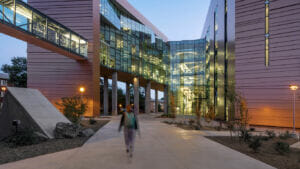Healthcare Reform – Healthy Choice?
Healthcare reform has been a national hot button lately, and with it comes a focus on all related industries, such as healthcare design and construction. With the development of proposed plans, comes the scrutiny of every penny allocated, prompting a public perception that the cost of healthcare facilities drives up the cost of healthcare. Because of this opinion, many healthcare operators are feeling pressure to decrease spending on their facilities to prevent a collective outcry.
Despite the myriad subjective view points on this issue, several facts substantiate that healthcare construction should not cease.
Injecting Capital Into Growth
History has proved that government-provided medicine hinders the development of new healthcare facilities and does nothing to foster innovation or improvement. There have been many newsworthy examples of limited investment in facilities maintenance programs and improvements, resulting in run-down, non-viable centers, which minimize effectiveness of healthcare delivery.
Capital expenditures (facilities and equipment) typically comprise 10% to 15% of a healthcare organization’s budget, while staff costs can total 60% or more. Spending on projects should not be limited, but instead examined to elicit greater efficiencies through planning and design.
Booming Healthcare
The Phoenix and Tucson metropolitan areas have invested in healthcare facilities, but rural areas still lack capacity. The Hill-Burton Act of 1946, implemented “to modernize hospitals that had become obsolete due to lack of capital investment,” caused a surge of rural hospitals to be built in the 1950s and ’60s. Many of these hospitals still exist in almost the same condition today as when they were first built — unable to support current clinical demands and technological needs.
According to a U.S. News and World Report article published earlier in 2009, Phoenix ranks No. 11 on the top 20 list of cities where baby boomers are likely to retire, based on the expected senior population growth. The oldest boomers will begin to retire in 2011, and the Valley is not ready to receive them.
Arizona is short 1.5 beds per 1,000 residents, based on the national average. Because the demand on our statewide facilities will increase, not investing in additional healthcare facilities now will yield a greater shortage in the future. Seventy-six million baby boomers are anticipated to have multiple chronic conditions due to longer life spans (90+ years is the fastest-growing demographic) and will require more in-patient and primary care.
Baby boomers don’t plan to live in traditional nursing homes, as they prefer a community-centered lifestyle. The “old school” model of long-term care won’t suffice, requiring innovative facilities to accommodate the increasing numbers in a supportive manner.
To compound the demographic dilemma, earlier this year the under-20 population, or Gen Y, surpassed the number of baby boomers. This cohort now comprises roughly 28% of the U.S. population and is fast becoming equally as influential as the boomers, but with new expectations. Because this generation is just now beginning to enter its child-bearing years, more women and children’s services will be in demand at the same time boomers’ healthcare needs peak.
Reviving Investment Through Operations
As the healthcare reform debate rages, investment in design and construction of healthcare facilities must continue. Implementing effective planning and design strategies can actually help to reduce operational costs, such as staffing, because of improved efficiencies. Investing in facility updates also emphasizes a focus on better patient care through the creation of quality, healthy environments that take advantage of current technologies and meet best-practice expectations at a minimum.
To help spawn the future success of healthcare in Arizona, it is necessary for design and construction to continue at the high caliber of success it has achieved — and lead the way to providing innovative healthcare programs and facilities for the nation’s aging and future generations.



